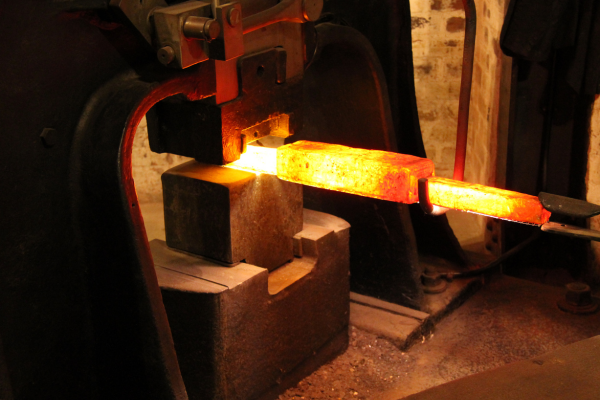Techniques of Open Die Forging

At Great Lakes Forge, we specialize in open-die forging. Also known as hammersmith forging, open-die forging utilizes several high-skill techniques to produce custom parts and components. This guide provides an overview of the open-die forging process, along with details about the advanced techniques used to create components with custom dimensions for a wide range of applications.
What Is the Open Die Forging Process?
Open-die forging is a time-tested metalworking process that utilizes skilled craftsmanship and powerful presses to form metal into various shapes. Unlike closed-die forging, which uses precisely shaped dies to form the metal, open-die forging allows for greater freedom of movement. The metal workpiece is positioned between dies and hammered or pressed to achieve the desired form, which includes blocks, discs, shafts, and other custom dimensions.
Common Applications for Open Die Forging
- Custom or one-off parts: Open-die forging allows for on-the-fly adjustments and shaping to meet your exact specifications. This is essential when you need a custom component that doesn't exist on the market.
- Forgings with simple shapes: Open-die forging is far more efficient than closed-die forging for components with simple dimensions, as it avoids the additional processes of designing and manufacturing a die.
- Large parts: Due to the open nature of the dies, workpieces are not confined to the dimensions of a closed die. Great Lakes Forge tackles hefty projects that traditional forging methods simply can't handle.
- Working with specific metals: Certain metals, like high-nickel alloys or tool steels, respond better to the controlled deformation of open-die forging compared to the high-pressure environment of closed-die forging. This allows for better grain structure and overall strength in the final product (View our in-depth comparison of open-die vs. closed-die forging for more information).
Advantages of Open Die Forgings
Unlike closed-die forging, open-die forging does not rely on the additional processes of designing and manufacturing a die to create the final product. Instead, this method works with the raw material, crafting the desired form in an open format. This allows for the creation of one-of-a-kind pieces that have enhanced properties and advantages, including:
- Improved fatigue resistance
- Continuous grain flow
- Exceptional strength
- Less chance of voids
- Finer grain size
Open Die Forging Techniques
The open-die forging process encompasses a variety of techniques to produce a desired shape, each with its own impact on forming the metal. By skillfully combining these techniques, our team of forging professionals can transform raw materials into complex shapes while maintaining the integrity and strength of the metal.
Fullering
Fullering involves creating grooves or indentations along a workpiece using a tool called a "fuller." Grooves are hammered into the metal to reduce its thickness in specific areas. Fullering is often used to create decorative patterns or to simply reduce a component's thickness in specific areas. It is also a technique that can be used to enhance the grip of an area on a component.
Edging
Edging shapes the edges of a workpiece, often for beveled or chamfered edges, using specialized tools like edging hammers. The edges of the workpiece are drawn out and thinned to the desired dimensions. Edging is used to create components requiring rounded or beveled edges for aesthetic, safety, or functionality purposes.
Cogging
Cogging utilizes flat dies to progressively compress a workpiece, reducing its thickness and increasing its length with each compression. This process refines the grain structure and mechanical properties of the workpiece. Cogging is typically used to produce shafts, bars, and other long metal components.
Upsetting
Unlike cogging, upsetting increases the cross-sectional area of a workpiece while decreasing its length. Upsetting achieves this by applying compressive force to the workpiece's end, causing another portion of the workpiece to expand. Upsetting is commonly used for forming heads or enlarged sections on metal components.
Open-Die Forging Capabilities for the Most Demanding Industrial Components
At Great Lakes Forge, our open-die forging process produces high-quality, durable components for rugged applications. For over 60 years, we’ve used our open-die forging capabilities to provide customers in a wide range of industrial sectors with reliable custom components. We offer a range of add-on services, including heat treating and CNC machining capabilities that allow us to form custom parts that meet your exact specifications. With a wide selection of high-performance materials and the fastest turnaround times in the industry, you can rely on GL Forge for your open-die forging needs.
Contact Us to Order Custom Open Die Forgings for Your Application
Ready to discuss your open-die forging project? Contact Great Lakes Forge today to learn how our expert open-die forging techniques can turn your metalworking concepts into reality. For pricing estimates on your project, request a quote online. GL Forge is your trusted source for top-quality open-die forgings.




